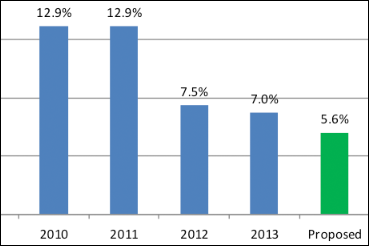 April 5, 2013 CONTACT: Chris Gilbride / Ted Timbers (718) 595-6600 Department of Environmental Protection Presents Fiscal Year 2014 Water Rate Proposal5.6% Proposed Increase is the Lowest in Eight YearsNew York City Department of Environmental Protection (DEP) Commissioner Carter Strickland today proposed a 5.6% increase in the Fiscal Year 2014 (FY14) water rate to the New York City Water Board. The 5.6% rate increase proposed for FY14 is the lowest increase in eight years and the fourth year in a row that the increase has come in significantly below the previous year’s projection. “Today we are able to propose a rate lower than we anticipated thanks in large part to our continued commitment to be more efficient and cut costs without sacrificing the quality of the services we provide to New Yorkers,” said Commissioner Strickland. “Still, we recognize that any rate increase can be a burden on our customers, and we will continue to look for ways to further tighten our belts and work with our regulators to reduce the burden of unfunded mandates so that New Yorkers get the best possible water and wastewater services at the most affordable rates.” What the Proposed Rate Would Mean for an Average CustomerIf the 5.6% water rate increase is adopted by the Board:
Rates are Lower Than Previously Projected Primarily Because:DEP has taken aggressive operational cost saving measures.
Revenue projections are higher than planned due to the near completion of DEP’s meter replacement and automated meter reading (AMR) device initiatives.
Regulatory and policy advances have enabled DEP better control its capital budget.
DEP has achieved substantial debt service savings in the low interest rate environment.
The Water Board is responsible for establishing the rate following the proposal and subsequent public hearings. The New York City Water Board has scheduled five public hearings for the upcoming FY14 water rate proposal: Staten IslandMonday, April 29 at 7:30 p.m. BrooklynTuesday, April 30 at 7:00 p.m. BronxWednesday, May 1 at 7:00 p.m. QueensThursday, May 2 at 7:00 p.m. ManhattanFriday, May 3 at 1:30 p.m. Information on the hearings can also be found by visiting www.nyc.gov/nycwaterboard. Following the five public hearings, the Water Board will formally adopt a FY 2014 water rate on May 10, 2013, and the new rate will become effective on July 1, 2013. DEP manages New York City’s water supply, providing more than one billion gallons of water each day to more than nine million residents, including eight million in New York City. The water is delivered from a watershed that extends more than 125 miles from the city, comprising 19 reservoirs and three controlled lakes. Approximately 7,000 miles of water mains, tunnels and aqueducts bring water to homes and businesses throughout the five boroughs, and 7,500 miles of sewer lines and 96 pump stations take wastewater to 14 in-city treatment plants. DEP has nearly 6,000 employees, including almost 1,000 in the upstate watershed. In addition, DEP has a robust capital program, with a planned $14 billion in investments over the next 10 years that will create up to 3,000 construction-related jobs per year. This capital program is responsible for critical projects like City Water Tunnel No. 3; the Staten Island Bluebelt program, an ecologically sound and cost-effective stormwater management system; the city’s Watershed Protection Program, which protects sensitive lands upstate near the city’s reservoirs in order to maintain their high water quality; and the installation of more than 820,000 Automated Meter Reading devices, which will allow customers to track their daily water use, more easily manage their accounts and be alerted to potential leaks on their properties. For more information, visit nyc.gov/dep, like us on Facebook at facebook.com/nycwater, or follow us on Twitter at twitter.com/nycwater. | ||